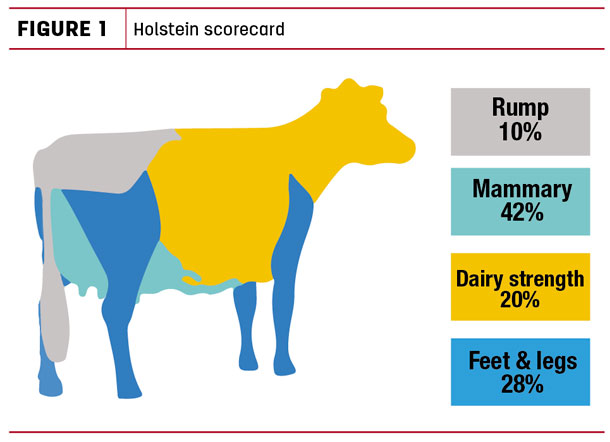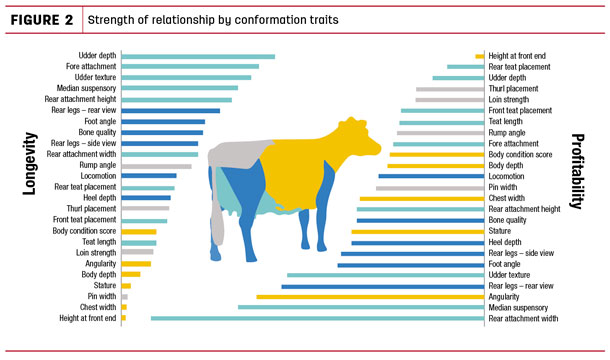Today’s dairy cow deals with some of the greatest challenges ever faced in the dairy industry. Some of these challenges include the stresses associated with unprecedented levels of production, the expectation for superior reproductive performance, high-energy rations and confined management characterized by constant exposure to concrete footing.
The length of a cow’s productive life in a herd directly affects its profitability; a longer herd life reduces replacement costs and increases the proportion of lactations from higher-yielding, mature animals.
Dairy cow survival is influenced by many genetic and non-genetic factors. Non-genetic factors include (but are not limited to) stall size and barn design, bedding, nutrition and reproduction, milk quota restrictions and the availability and affordability of replacement heifers.
Genetic factors include (but are not limited to) the genetic capability for high production and desirable milk components, calving ease, achieving normal reproductive efficiency, resisting mastitis and metabolic disorders, and maintaining proper foot conformation, which minimizes lameness.
Well-managed animals are much more likely to achieve their full genetic potential. Animals that do not meet their genetic potential are more likely to leave the herd prematurely.
Over the past 100 years, genetic progress has hugely influenced dairy breeds. In the first 50 years, this progress was made without the benefit of A.I., embryo transfer or genomic evaluations.
Now with all of the genetic improvement tools we have at our disposal, the opportunity for rapid genetic progress has never been greater.
Classification is a comprehensive evaluation of the physical structure of a dairy animal, a comparison of its actual conformation to that of the ideal cow.
This is known as “true type,” which represents the perfect balance of traits needed for high production, fertility, management ease, longevity, health and welfare.
Traditionally, the primary focus of the classification system was the overall Final Class (score), while a lesser emphasis was placed on the detailed appraisal of individual traits that identify conformational strengths and weaknesses.
Final Class still carries importance and prestige in herds with a long-standing investment in achieving excellence in dairy cattle type selection.
Over the past decades, there has been a dramatic shift in the use of classification as a herd improvement tool, and it now focuses on a comprehensive set of descriptive traits that describe the animal’s strengths and weaknesses, and depicting its overall functionality.
If we ignore all of the individual conformation traits, as some producers and researchers have suggested, we will lose the great monitoring tool we have for measuring conformational change and evaluating which of the changes are desirable and where breeding programs must be modified.
An example of this is the introduction of foot lesion data and the initiative to review the way foot traits are currently evaluated. This is a proactive step to better evaluate foot conformation and provide an effective tool to reduce lameness.
The ultimate goal has been to review the evaluation of Feet and Leg conformation traits and modify both the evaluation of the individual traits and the emphasis given to each trait to ensure functionality in confinement housing systems is given maximum priority.
This approach is critical to ensure Feet and Leg conformation evaluation truly identifies the most desirable foot that minimizes lameness in a confined management environment.
Another example is the modification of the emphasis given to some of the udder traits such as proper teat placement, teat length and levelness of the udder floor. These traits have become particularly important with the large increase in robotic milking systems.
Without individual trait evaluation, it will be difficult to monitor the progress made with these important anatomical characteristics.
It is well recognized management changes can bring about much more rapid results than genetic selection pressures, but we must be careful not to become so short-sighted as to focus only on the day-to-day management factors and ignore the long-term benefits that have been achieved through comprehensive assessment of individual functional conformation traits.
We must remember the accurate measurement of these important functional traits is critical to achieve the genetic progress necessary to produce the most desirable functional conformation and allow for the maximum phenotypic expression of the genetic potential for production, reproduction and appropriate animal welfare.
The Canadian Holstein classification scorecard is made up of 25 linear traits (eight actual measurements), 25 defective characteristic traits and one research trait (locomotion), split between four sections: Mammary System, Feet and Legs, Dairy Strength and Rump (Figure 1).

The classifiers’ handheld computers assign codes for the measurements and make adjustments for the measurements according to age at calving, stage of lactation and udder fullness. Once all data has been collected and inputted, the four section scores and final score are automatically generated.
In Canada, there has been a large reduction in the number of herds, with many of the 50- to 60-cow tiestall dairies having been replaced by 200-plus-cow freestall dairies.
The focus on the individual cow and livestock shows has, in many cases, been replaced by a focus on maximizing production and profitability, and developing sophisticated herd management programs.
It has often been recognized there is a disconnection between the type of cow sought after by the commercial breeder compared to the type of cow winning in the show ring.
With today’s dairy businesses being more commercially oriented and less focused on the individual animal, generating interest in breed improvement programs such as classification will be challenging.
We must find ways to clearly identify the relationship between functional type and longevity, and demonstrate the profitability benefits associated with achieving the correct functional conformation. The commercial breeder’s perception of the correct functional type will inevitably be different than the show ring breeder.
The gap between the type of cow winning the show and the type demanded by the commercial breeder has already begun to narrow. Many show enthusiasts appreciate cows that are wide, angular, well-sprung and well-sloped with strong ligament strength and attachments.
These are the same characteristics that give an animal resistance to break down, capacity for high volumes of milk and reproductive soundness. This means the cow at the show and the cow in the barn should be the same cow.
It should be the mission of all Holstein breeders to ensure the show ring remains the venue to demonstrate excellence in functional conformation and serves as a celebration for the entire dairy industry of their commitment to genetic progress in productivity, longevity and animal welfare.
Cow profitability and longevity go hand-in-hand; it is hard to have one without the other. The classification program is designed to identify cows with optimal workability and cows with the natural ability to produce higher volumes of milk over longer lifetimes.
Figure 2 displays the strength of relationship conformation traits have in relation to longevity and profitability.

For an animal to remain in the herd for an extended period of time, its Mammary System and Feet and Legs must be sound, functional and productive. In order for an animal to be profitable while it is in the herd, the animal needs to be a balanced cow in order to remain healthy, productive, durable and functional.
The graph was created using the same DHI profit data that was used to create Pro$. The strength of relationship was calculated using trait points to accommodate intermediate optimums and ideal linear scores.
For questions on this article or inquiries about the classification program, contact Holstein Canada’s Classification department either by email or toll- free (855) 756-8300 ext. 290.






